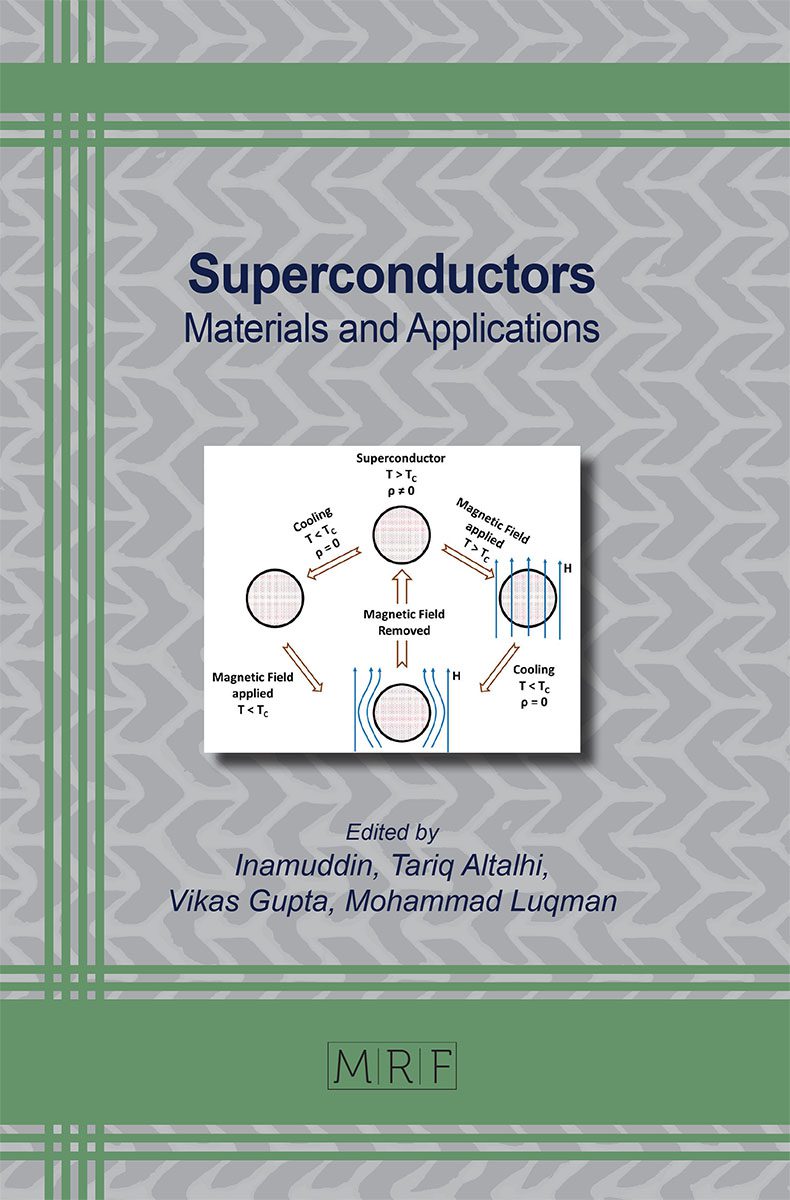Type I Superconductors: Materials and Applications
Prashant Hitaishi, Rohit Verma, Parul Khurana and Sheenam Thatai
Superconductors are materials that show properties of perfect diamagnetism and zero resistivity or infinite conductivity below a well-defined temperature known as critical temperature and, in the presence of a magnetic field that is less than a critical value. Based on their behaviour to the externally applied magnetic field, superconductors are divided into two categories; Type-I and Type-II superconductors. In this chapter, we have described various Type-I superconductors, their critical temperatures, history of superconductivity, physical properties, applications, and recent researches on Type-I superconductors, various theories proposed for explaining their properties, and different applications of superconductors.
Keywords
Superconductors (SCs), Type-I SCs, Meissner Effect, Theories of Low-Temperature Superconductors, Applications of Superconductors
Published online 10/5/2022, 23 pages
Citation: Prashant Hitaishi, Rohit Verma, Parul Khurana and Sheenam Thatai, Type I Superconductors: Materials and Applications, Materials Research Foundations, Vol. 132, pp 108-130, 2022
DOI: https://doi.org/10.21741/9781644902110-6
Part of the book on Superconductors
References
[1] S. J. Blundell, Superconductivity: A Very Short Introduction. OUP Oxford, 2009. https://doi.org/10.1093/actrade/9780199540907.001.0001
[2] B.T. Matthias, T.H. Geballe, V.B. Compton, Superconductivity, Rev. Mod. Phys. 35 (1963) 1. https://doi.org/10.1103/RevModPhys.35.1
[3] Heike Kamerlingh Onnes – Nobel Lecture: Investigations into the Properties of Substances at Low Temperatures, which Have Led, amongst Other Things, to the Preparation of Liquid Helium. “Physics Nobel prize 1913.”
[4] Rohlf, J. W. “Wiley: Modern Physics from alpha to Z0-James William Rohlf.” (1994).
[5] E. Kaxiras, Atomic and Electronic Structure of Solids, At. Electron. Struct. Solids. (2003). https://doi.org/10.1017/CBO9780511755545
[6] C. Buchal, F. Pobell, R.M. Mueller, M. Kubota, J.R. Owers-Bradley, Superconductivity of Rhodium at Ultralow Temperatures, Phys. Rev. Lett. 50 (1983) 64. https://doi.org/10.1103/PhysRevLett.50.64
[7] R.D. Fowler, B.T. Matthias, L.B. Asprey, H.H. Hill, J.D.G. Lindsay, C.E. Olsen, R.W. White, Superconductivity of Protactinium, Phys. Rev. Lett. 15 (1965) 860. https://doi.org/10.1103/PhysRevLett.15.860
[8] D.R. Lide, CRC handbook of chemistry and physics, CRC press, 2004.
[9] R.L. Falge, Superconductivity of hexagonal beryllium, Phys. Lett. A. 24 (1967) 579-580. https://doi.org/10.1016/0375-9601(67)90624-X
[10] J. Eisenstein, Superconducting Elements, Rev. Mod. Phys. 26 (1954) 277. https://doi.org/10.1103/RevModPhys.26.277
[11] G. Seidel, P.H. Keesom, Specific Heat of Gallium and Zinc in the Normal and Superconducting States, Phys. Rev. 112 (1958) 1083. https://doi.org/10.1103/PhysRev.112.1083
[12] J.F. Cochran, D.E. Mapother, Superconducting Transition in Aluminum, Phys. Rev. 111 (1958) 132. https://doi.org/10.1103/PhysRev.111.132
[13] K.I. Wysokinski, Remarks on the first hundred years of superconductivity, Acta Phys. Pol. A. 121 (2011) 721-725. https://doi.org/10.12693/APhysPolA.121.721
[14] E. Maxwell, Isotope Effect in the Superconductivity of Mercury, Phys. Rev. 78 (1950) 477. https://doi.org/10.1103/PhysRev.78.477
[15] C.A. Reynolds, B. Serin, W.H. Wright, L.B. Nesbitt, Superconductivity of Isotopes of Mercury, Phys. Rev. 78 (1950) 487. https://doi.org/10.1103/PhysRev.78.487
[16] The electromagnetic equations of the supraconductor, Proc. R. Soc. London. Ser. A – Math. Phys. Sci. 149 (1935) 71-88. https://doi.org/10.1098/rspa.1935.0048
[17] M. Cyrot, Ginzburg-Landau theory for superconductors, Reports Prog. Phys. 36 (1973) 103. https://doi.org/10.1088/0034-4885/36/2/001
[18] J. Bardeen, L.N. Cooper, J.R. Schrieffer, Theory of Superconductivity, Phys. Rev. 108 (1957) 1175. https://doi.org/10.1103/PhysRev.108.1175
[19] T. Nakamura, Y. Itoh, M. Yoshikawa, T. Oka, J. Uzawa, Development of a superconducting magnet for nuclear magnetic resonance using bulk high-temperature superconducting materials, Concepts Magn. Reson. Part B Magn. Reson. Eng. 31B (2007) 65-70. https://doi.org/10.1002/cmr.b.20083
[20] K. Ogawa, T. Nakamura, Y. Terada, K. Kose, T. Haishi, Development of a magnetic resonance microscope using a high Tc bulk superconducting magnet, Appl. Phys. Lett. 98 (2011) 234101. https://doi.org/10.1063/1.3598440
[21] K. Takahashi, H. Fujishiro, M.D. Ainslie, A new concept of a hybrid trapped field magnet lens, Supercond. Sci. Technol. 31 (2018) 044005. https://doi.org/10.1088/1361-6668/aaae94
[22] H. Fujishiro, M. Ikebe, H. Teshima, H. Hirano, Low-thermal-conductive DyBaCuO bulk superconductor for current lead application, IEEE Trans. Appl. Supercond. 16 (2006) 1007-1010. https://doi.org/10.1109/TASC.2006.871305
[23] H. Deng, Y. Wu, Y. Zheng, N. Akhtar, J. Fan, X. Zhu, J. Li, Y. Jin, D. Zheng, Working Point Adjustable DC-SQUID for the Readout of Gap Tunable Flux Qubit, IEEE Trans. Appl. Supercond. 25 (2015). https://doi.org/10.1109/TASC.2015.2399272
[24] T. Polakovic, W.R. Armstrong, V. Yefremenko, J.E. Pearson, K. Hafidi, G. Karapetrov, Z.E. Meziani, V. Novosad, Superconducting nanowires as high-rate photon detectors in strong magnetic fields, Nucl. Instruments Methods Phys. Res. Sect. A Accel. Spectrometers, Detect. Assoc. Equip. 959 (2020) 163543. https://doi.org/10.1016/j.nima.2020.163543
[25] L. Schultz, O. De Haas, P. Verges, C. Beyer, S. Röhlig, H. Olsen, L. Kühn, D. Berger, U. Noteboom, U. Funk, Superconductively levitated transport system-the SupraTrans project, IEEE Trans. Appl. Supercond. 15 (2005) 2301-2305. https://doi.org/10.1109/TASC.2005.849636
[26] G.G. Sotelo, D.H.N. Dias, O.J. Machado, E.D. David, R. de A. Jr, R.M. Stephan, G.C. Costa, Experiments in a real scale maglev vehicle prototype, J. Phys. Conf. Ser. 234 (2010) 032054. https://doi.org/10.1088/1742-6596/234/3/032054
































